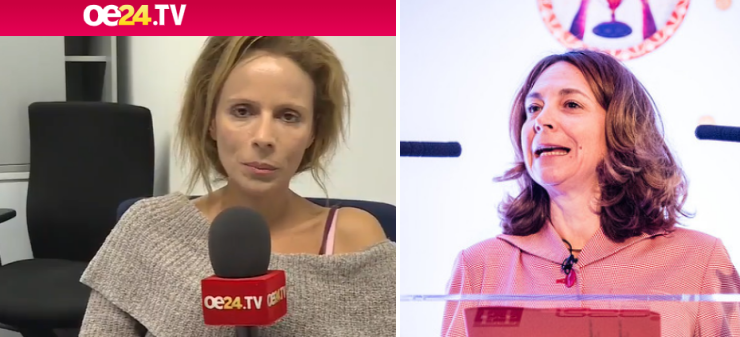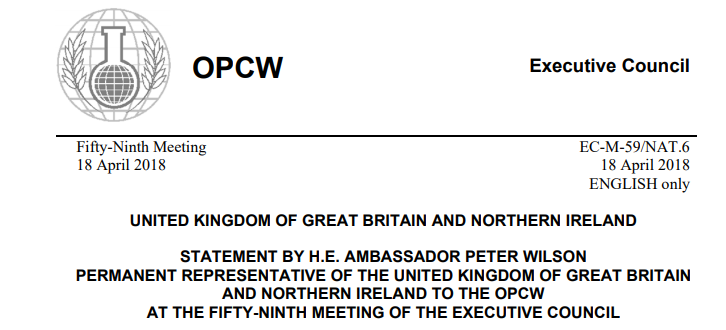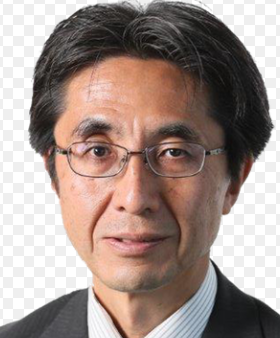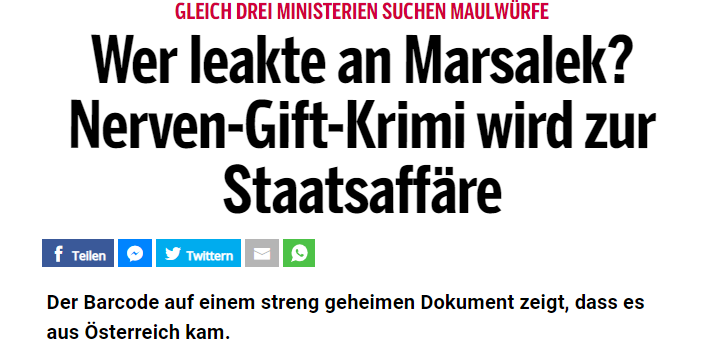AUSTRIA CONFIRMS OPCW REPORT ON SKRIPAL FAKING BY THE BRITISH – VIENNA EXPOSES FINANCIAL TIMES LIES AND COVER-UP
by John Helmer, Moscow
Dances with Bears
Austria officially confirmed this week that the British Government’s allegation that Novichok, a Russian chemical warfare agent, was used in England by GRU, the Russian military intelligence service, in March 2018, was a British invention.
Investigations in Vienna by four Austrian government ministries, the BVT intelligence agency, and by Austrian prosecutors have revealed that secret OPCW reports on the blood testing of Sergei and Yulia Skripal, copies of which were transferred to the Austrian government, did not reveal a Russian-made nerve agent.
Two reports, published in Vienna this week by the OE media group and reporter Isabelle Daniel, reveal that the Financial Times publication of the cover-page of one of the OPCW reports exposed a barcode identifying the source of the leaked documents was the Austrian government. The Austrian Foreign Ministry and the Bundesamt für Verfassungsschutz und Terrorismusbekämpfung (BVT), the domestic intelligence agency equivalent to MI5 or FBI, have corroborated the authenticity of the documents.
The Austrian disclosures also reveal that in London the Financial Times editor, Roula Khalaf, four of the newspaper’s reporters, and the management of the Japanese-owned company have fabricated a false and misleading version of the OPCW evidence and have covered up British government lying on the Skripal blood testing and the Novichok evidence.
On Wednesday afternoon this week, OE24, a news portal of the OE media group in Vienna, broke the first story (lead image, right) that the barcode found on the OPCW document photograph published in London had been traced to several Austrian state ministries. The next day, OE political editor Isabelle Daniel reported the Austrian Foreign, Defence and Economics Ministries had received copies of the barcoded OPCW dossier, and that the Justice Ministry and prosecutors were investigating “potential moles”.
Daniel also quoted a Foreign Ministry source as saying its copy of the documents had been securely stored in its disarmament department safe, and that there were “no tips” the leak had come from there. Daniel also quoted a BVT spokesman as confirming the authenticity of the OPCW file had been verified. “We have checked it recently. Officially it has not come to us.”

Left: Isabelle Daniel of OE, Vienna. Right, Roula Khalaf Razzouk, editor of the Financial Times since her recent appointment by the Nikkei group, the newspaper’s owner. Her full name and concealment of her Lebanese political and business interests can be followed here. The names of the four Financial Times reporters who have participated in the misrepresentation and cover-up are Paul Murphy, investigations editor; Dan McCrum, a reporter; Helen Warrell, NATO correspondent; and Max Seddon of the Moscow bureau.
The leak had been an “explosive secret betrayal” and a criminal investigation was under way, OE24 reported. OE is a privately owned Austrian media group, based in Vienna. It publishes a newspaper, the news portal OE.at, radio and television.
The Financial Times report first exposing the OPCW documents appeared on July 9. Details of how the newspaper fabricated the interpretation the OPCW had corroborated Russian involvement in the Novichok attack can be read here. For the full Skripal story, read the book.
At an OPCW Executive Council meeting on April 14, 2018, five weeks after the Skripal attack, the British Government confirmed that a few days earlier “all States parties” had received copies of the OPCW dossier. This included Austria, as the Viennese sources now acknowledge.

Source: https://www.opcw.org/
“The OPCW responded promptly to our request to send their experts to the United Kingdom,” declared Peter Wilson, the British representative to the OPCW on April 14, 2018. “They conducted a highly professional mission. The OPCW’s designated laboratories have also responded professionally and promptly. What the Director-General said was really important on this, and the Technical Secretariat’s presentation shows how professional that work was. The report the Technical Secretariat presented to us on 11 April was thorough and methodical. The Technical Secretariat responded quickly to our request to share that report with all States Parties. All have had the chance to see the quality of that work.”
Wilson went on to say: “As you know, on 4 March Yulia and Sergei Skripal were poisoned in Salisbury, the United Kingdom, with a chemical weapon, which United Kingdom experts established to be a Novichok. OPCW has now clearly verified those findings.”
The Austrian copy of the OPCW file now confirms this was a misrepresentation of the chemical formula and other evidence the OPCW had gathered.
Wilson went on to conclude: “the identification of the nerve agent used is an essential piece of technical evidence in our investigation, neither DSTL’s [Defence Science and Technology Laboratory at Porton Down] analysis, nor the OPCW’s report, identifies the country or laboratory of origin of the agent used in this attack. So let me also set out the wider picture, which leads the United Kingdom to assess that there is no plausible alternative explanation for what happened in Salisbury than Russian State responsibility. We believe that only the Russian Federation had the technical means, operational experience, and the motive to target the Skripals.”
The first qualifying sentence was the British truth; the conclusion was the British lie. The Austrian evidence now verifies there was no evidence of a Russian source in the blood and other test samples; no evidence of Novichok; and no evidence to corroborate the British allegations of a Russian chemical warfare attack.
In its report, the Financial Times displayed a partial photograph of the cover-page of one of the OPCW documents in its possession (lead image, left). A classification stamp appears to be showing through the title page, but no barcode is visible. The London newspaper appears to have cropped the published picture so as to hide the barcode. That concealment — proof of the Austrian source – allowed the newspaper reporters to claim the source of the document was unknown, probably Russian, as the headline implied: “Wirecard executive Jan Marsalek touted Russian nerve gas documents.”
A British military source was reported as claiming “the documents were ‘unlikely’ to have come from OPCW member states in western Europe or the US.” Khalaf and her reporters added: “The OPCW, which is based in The Hague, said this week that it was investigating the matter, but declined further comment. The Kremlin did not immediately respond to a request for comment.” With the barcode in their possession but hidden, they knew they were publishing a combination of disinformation and lies.
The disclosure of the barcode to the Austrians appears to have followed after they had requested it from Khalaf. She checked with her superiors in the newspaper management before handing it over. They believed they were doing so in secret.

It is not known if Motohiro Matsumoto (right), the Nikkei executive responsible for the London publishing company, was alerted and gave his authorization; he refuses to answer questions. Matsumoto, one of the five directors of Financial Times Ltd., is the general manager of Nikkei’s global business division. He takes
his running orders from Nikkei’s chairman and a long-time media executive, Tsuneo Kita. Matsumoto replaced Hirotomo Nomura at the head of the Financial Times on March 25, 2020. When Nikkei bought the newspaper from Pearson Plc in 2015, Nikkei became its sole proprietor.
The Austrian press has yet to report how the barcode was obtained from the newspaper. Because the BVT and state prosecutors in Vienna are involved in their search for the “moles”, it is likely they contacted their counterparts at MI5 and the Home Office, and that the newspaper agreed to hand over its copy of the OPCW file to the latter. The collaboration of the journalists with the secret services to falsify evidence against Moscow in the Novichok story remains a sensitive secret.

Source: https://m.oe24.at/
Khalaf has refused repeated requests for comment. Max Seddon, the newspaper’s Moscow reporter, was also asked for additional information about the photograph of the cover-page. He will not answer.
